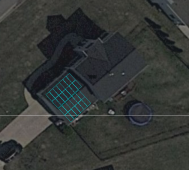I live in southern Wisconsin and I'm working on plans for a solar system. I'd like a system that is off-grid but would keep the utility for backup and larger loads as needed. It would be a plus if I could sell power back to the utility in the instances where I have extra solar being generated but I'm assuming that comes with some negatives and might complicate the system so I'm not completely set on that idea. Anyone by chance have WE Energies, southeast WI, for their electric and know how a grid tied system would work?
Looking at my electric bill my average usage is generally around 21kWh/day (~650kWh/mo) but ranges from 15kWh up to 35kWh/day in the hottest few months of the summer due to the central air A/C (heat is natural gas). The caveat to this usage is that I have a hot tub coming which is 240V rated at 48 amps on a 60 amp breaker (heater is 5.5kW). I think the hot tub might be too big to expect to run on solar without some specifically sized system but this isn't terribly important to me as I'm more concern with powering the more essential needs and appliances. Self sufficiency is one of the major draws for me towards going solar and the tub is more of a luxury of course.
The system I'm considering might be something like this, but I'd love feedback from anyone more experienced and willing to help. Nothing set in stone for sure:
Panels: (24) Renesola 370W Mono, 8880W total (having difficulty in finding any reviews on the quality on these but price is good for new panels, $.40/W (planning to mount on the roof of my attached garage, no shading except from the 2 story portion of the house shades the garage roof in the very early morning hours)
Inverters: (2) Growatt 5kW SPF 5000 ES-US, 10kW total (was also considering the MPP LV6548)
Batteries: (3) EG4-LifePower4 Lithium Battery 48V 100AH, 15.36kWh total
So how do I plan for which of my home circuits to actually run off of my solar system? I'm trying to gauge how much of my electric bill I can offset but also how useful the system will be in a power outage scenario.
My 2,000 sq-ft home has the following:
Refrigerator (newer LG linear inverter, would need to check the specs)
Freezers (2 new samsung uprights and 2 smaller chest style) - definitely would want to keep these and the fridge powered
Lighting / TV / etc
Electric clothes washer 120vac
Natural gas heated dryer with 120vac
Electric convection oven/range 240vac
Microwave
Dishwasher
Sump pump
Central AC
Natural gas furnace and water heater (can I run the furnace blower/electrical requirements with my setup?)
I have city water, no well pump
Open to any thoughts and suggestions on what I should try to run or changes to the system I've begun to lay out.
Looking at my electric bill my average usage is generally around 21kWh/day (~650kWh/mo) but ranges from 15kWh up to 35kWh/day in the hottest few months of the summer due to the central air A/C (heat is natural gas). The caveat to this usage is that I have a hot tub coming which is 240V rated at 48 amps on a 60 amp breaker (heater is 5.5kW). I think the hot tub might be too big to expect to run on solar without some specifically sized system but this isn't terribly important to me as I'm more concern with powering the more essential needs and appliances. Self sufficiency is one of the major draws for me towards going solar and the tub is more of a luxury of course.
The system I'm considering might be something like this, but I'd love feedback from anyone more experienced and willing to help. Nothing set in stone for sure:
Panels: (24) Renesola 370W Mono, 8880W total (having difficulty in finding any reviews on the quality on these but price is good for new panels, $.40/W (planning to mount on the roof of my attached garage, no shading except from the 2 story portion of the house shades the garage roof in the very early morning hours)
Inverters: (2) Growatt 5kW SPF 5000 ES-US, 10kW total (was also considering the MPP LV6548)
Batteries: (3) EG4-LifePower4 Lithium Battery 48V 100AH, 15.36kWh total
So how do I plan for which of my home circuits to actually run off of my solar system? I'm trying to gauge how much of my electric bill I can offset but also how useful the system will be in a power outage scenario.
My 2,000 sq-ft home has the following:
Refrigerator (newer LG linear inverter, would need to check the specs)
Freezers (2 new samsung uprights and 2 smaller chest style) - definitely would want to keep these and the fridge powered
Lighting / TV / etc
Electric clothes washer 120vac
Natural gas heated dryer with 120vac
Electric convection oven/range 240vac
Microwave
Dishwasher
Sump pump
Central AC
Natural gas furnace and water heater (can I run the furnace blower/electrical requirements with my setup?)
I have city water, no well pump
Open to any thoughts and suggestions on what I should try to run or changes to the system I've begun to lay out.



